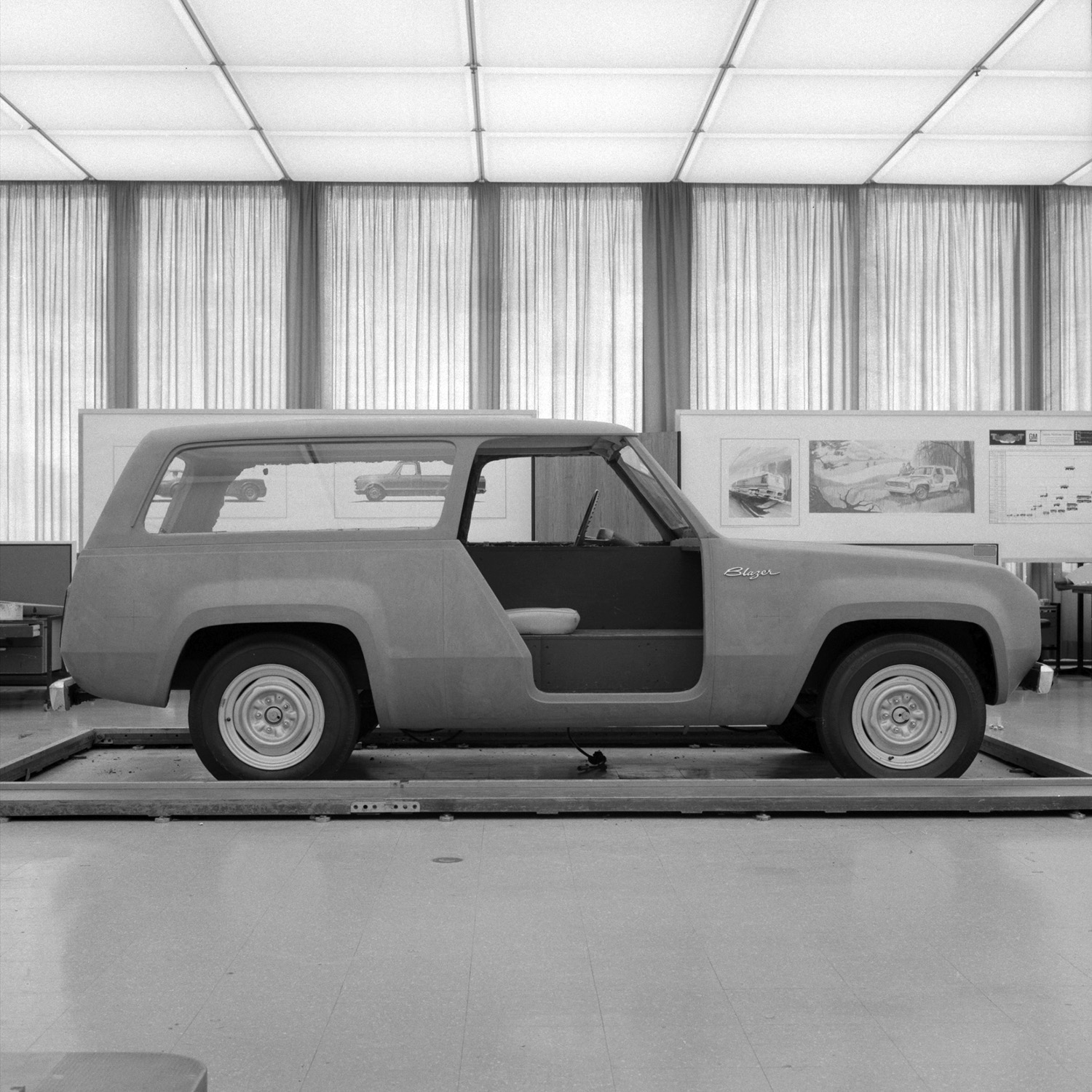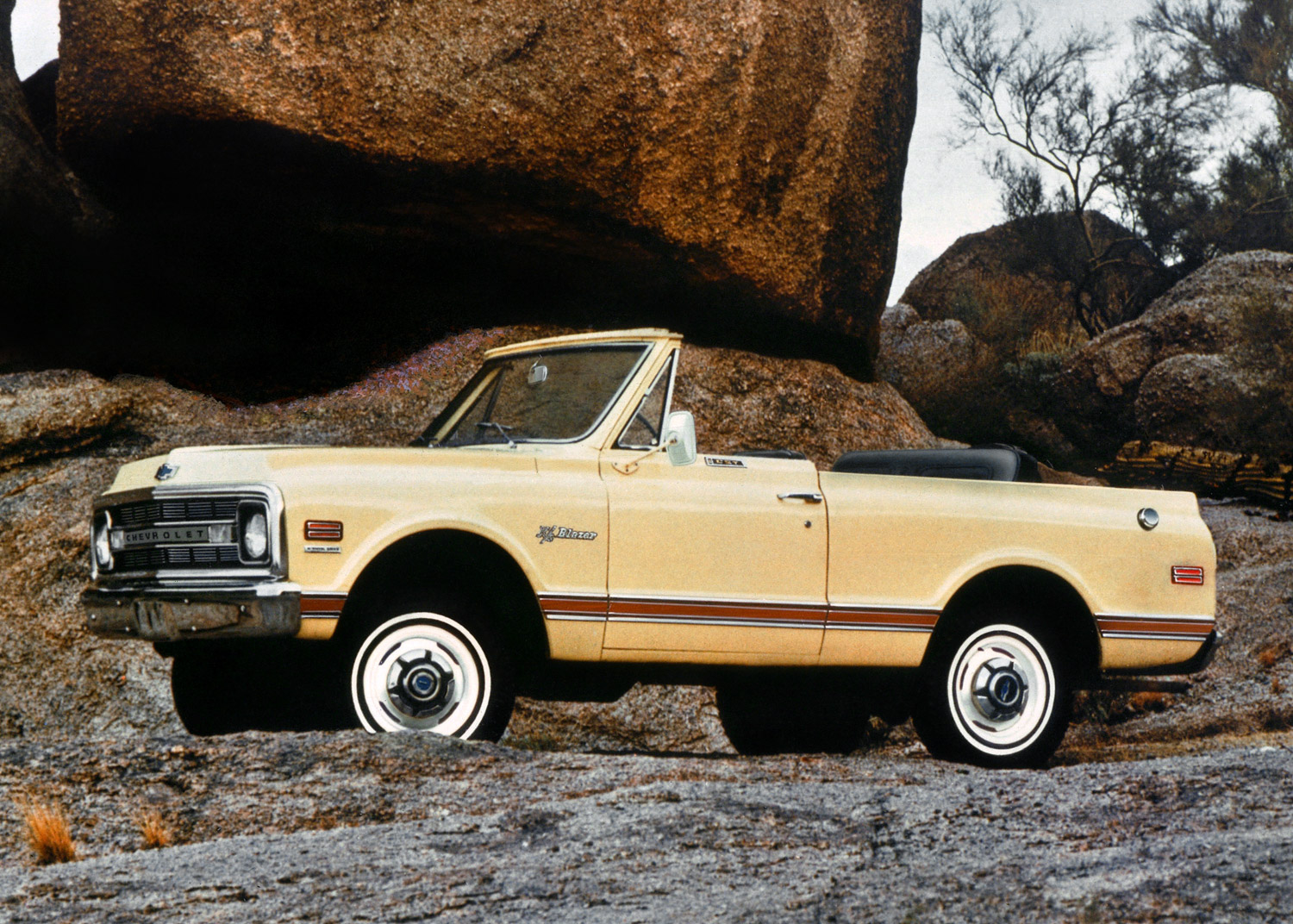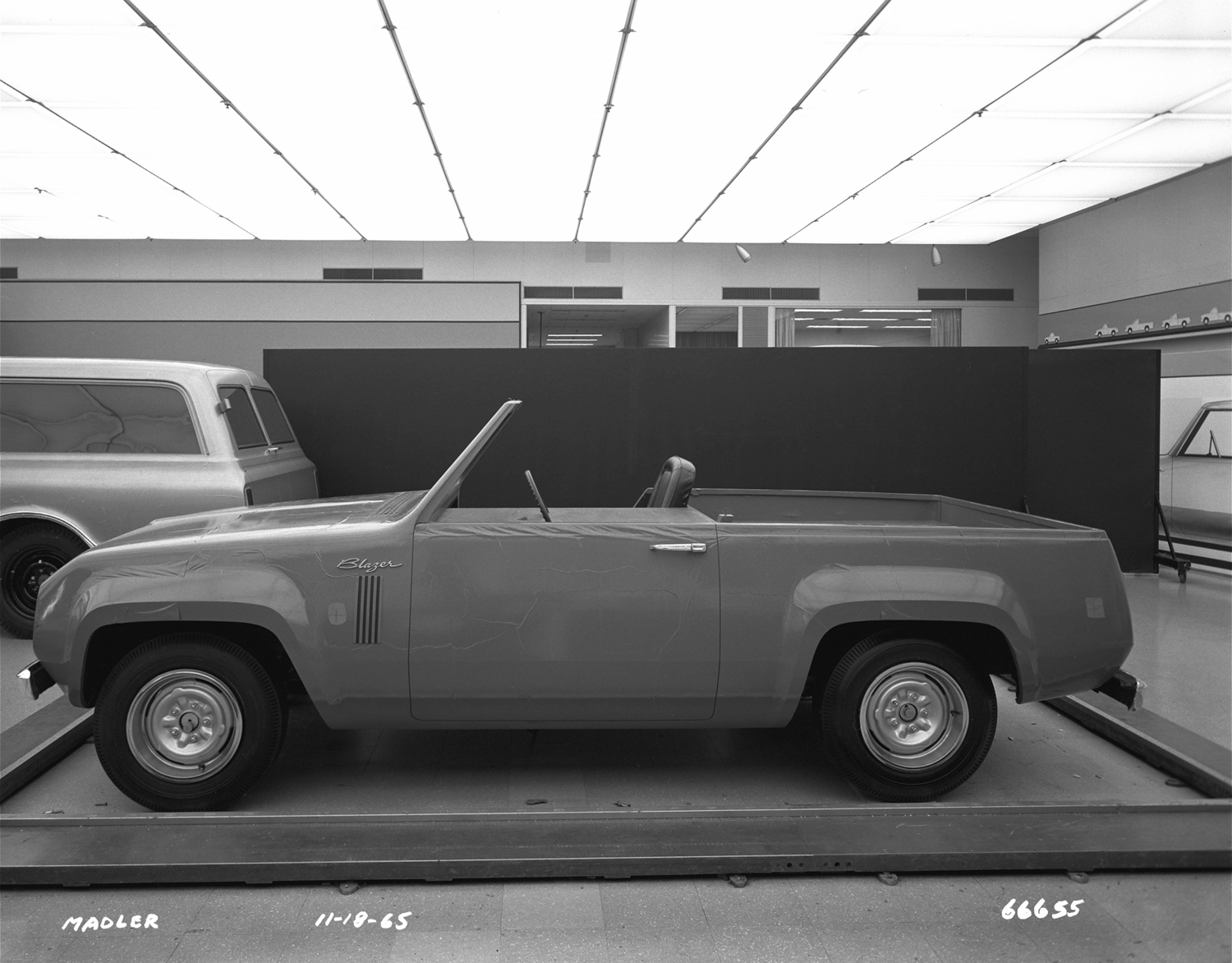The old-school Chevrolet Blazer that never was
The legend of the Chevrolet Blazer is well established, and known to many enthusiasts: Ford introduces Bronco in ‘65 as a 1966 model year, in a fit of equine-themed offerings starting with the Mustang. Dearborn enjoys wild success for four model years while Chevrolet/GMC sits on its hands and waits for the commotion to blow over before introducing its own sport-utility vehicle, the K5 Blazer and Jimmy.
On the 50th anniversary year of the original K5 Blazer, an all-new Blazer hits the showroom. It’s a shadow of its former (cool) K5 self, but its arrival is a good opportunity to set the record straight about the development of the K5 Blazer and what was going on in those long four model years before GM finally introduced a two-door SUV of its own.
These photos, courtesy of the GM Media Archive, show that GM was contemplating a completely different direction for the Blazer—one that could have packed on a few sales in those years when the company simply had no competitive product to take on the Bronco. But how much of a difference would it have made?
The crowded field

Let’s backtrack to the years before August 1965, when Ford officially launched the Bronco. The idea was that the Bronco was a literal “stablemate” to the Mustang, conceived by the major players who greenlit the pony car: Donald Frey (supervising product manager) and Lee Iacocca (vice president of all Ford cars and trucks).
The brief for the vehicle that Ford developed wasn’t really new, especially with the International Harvester and Jeep already in the market. It was new for Ford, though, and it featured several advantages over existing competitors. The big difference was a standard inline-six-cylinder engine, when many vehicles in this class had four-cylinders as either the base or only available engine. Add in the availability of a 289-cubic inch V-8 and the Bronco left the gate with a major powertrain advantage.
Still, the Bronco trotted into a saturated field of what were considered off-road vehicles. The 400-pound gorilla was the Jeep CJ5, which wasn’t new, but had an all-new Buick Dauntless V-6 that countered the gripes that the Hurricane four-cylinder didn’t have the gusto to work as an on-road vehicle. International Harvester had its own updated contender with the all-new Scout 800 for 1965. It didn’t look all that revised but had a host of creature-comfort improvements including bucket seats, better heat, more complete instrumentation and an available 232-cu in inline six. IH would offer its own 266-cu-in V-8 to counter Ford in 1967.
If you were an ambitious off-road vehicle shopper, Ford, Jeep, and IH were just the start. By 1965, the FJ40 Land Cruiser was the best-selling Toyota in the United States. Nissan made a few inroads with its own second-generation Patrol. British Land Rovers had been selling in the United States since the 1950s, and with the introduction of the Series IIa in 1961, it came with a much more reliable 12-volt, negative-ground electrical system.
GM’s pre-Blazer prototype


GM was paying close attention to what these competitors offered. “We knew there was something happening here,” said Harry Bentley Bradley in a terrific, wide-ranging interview about Chevrolet truck design in the May 2003 issue of Classic Trucks.
Bradley and the Chevrolet Truck Studio quickly clay modeled its own Bronco/CJ/Scout/FJ/Patrol/Land Rover competitor, which is the Blazer you see in these photos.
Bradley notes that this Blazer concept shared nothing (presumably other than a powertrain) with any other Chevy product, and it’s abundantly clear that it shares nothing with the C10 pickup, in particular. The concept rides on a wheelbase much closer to the 97 inches between the wheels of the Bronco. It’s also much narrower than the C10, again to fit a similar footprint as the Jeep CJ and the rest of the competitive field..
Bradley suggests that this pre-K5 Blazer, which could’ve hit the streets and trails as quickly as 1968, was a lot further along than these studio mockups suggest. “It was fully engineered, completely tooled, and it was gorgeous!” he told Jim Ault in 2003. “I mean, brochures were done. The tooling was finished. Pre-production prototypes were tested. It was like this far away from being at the Chevrolet showrooms in 1968.”
In the Classic Trucks interview, there’s no mistaking Bradley’s frustration that those long-standing designer and engineer foils—the accountants—killed the project. “We thought that little thing was just glorious. It was a really beautiful, truck-like piece and then suddenly it was cancelled. I was so disgusted when they scrapped it that I did [a] rendering just as a slam against corporate decision-making.”
In Bradley’s eyes, the decision to pass on the design was a huge missed opportunity for GM. “Then all of a sudden the sales on Broncos, Scouts and the Jeepster [Commando] went up like gangbusters.”
Keeping it all in perspective

“Gangbusters” is a huge stretch, though, if you take a look at the actual sales numbers. Despite being a sport-utility icon and a benchmark in Ford design, the numbers for the Bronco were not great. In the ‘64 ½ and ‘65 model years, Ford blew out 686,000 Mustangs. For 1966, Ford sold just 23,776 Broncos in all three body configurations, according to data provided from Tom Commero at Hemmings Motor News. A year later, that number dropped to 14,130. In the years later, Bronco sales would always hover around 20,000 units a year.
That’s almost exactly as successful as the International Harvester Scout 800. In 1965, I-H sold 20,216 Scout 800s (with a few remaining Scout 80s in the mix). Same story at Jeep: Between 1965 and 1969, the American icon only broke the 20,000 unit mark twice. Land Rover, Toyota and Nissan wouldn’t sell that many Series IIas, FJs, and Patrols combined.
If you’re a GM executive looking at Ford selling as many Broncos as I-H sold Scout 800s, that has to look like an act you do not want to follow.
It’s not unheard for GM to sell a vehicle on a completely separate platform in 1965; just take a look at the Corvair. But doing so requires volume. Chevrolet sold more than 237,000 Corvairs in 1965. Harry Bentley Bradley commented: “GM management suddenly said ‘Look [laughs] there’s not nearly enough buyers out there to support International, Jeep, and now Ford. If Chevy comes out, nobody’s going to buy it.’”
And they were 100 percent on the money. That market was completely and demonstrably saturated.
Blazer flavor

When it finally introduced a K5 Blazer in 1969, Chevy hit on a formula that made sense: A shortened version of an existing vehicle that wouldn’t cost a lot in development; one that could double as a daily driver for a lot more Americans than a Bronco ever could. The first generation K5 Blazer wasn’t an instant success, selling just a few thousand units the first year, but by its last year in 1972, it sold twice as many units as the Bronco did in its best year ever. In 1973 and 1974, the second-generation K5 sold more than 175,000 units.
Ford would find itself in the same position between 1973 and 1977 as GM was when the Bronco launched, watching from the sidelines without a competitive product. Only this time, those sales represented real numbers. Ford finally introduced a full-size Bronco in 1978. In its second of a two-year production run, Ford quintupled the best sales year of the 1966 to 1977 Bronco.
Ford never looked back. The full-size SUV was here to stay.





They ought to be ashamed of themselves for calling that crossover that they sell now a Blazer. No respect for their own name. If they made a proper Blazer now based off of the full sized pickup they would have that market completely to themselves. If they wanted to they could compete directly with the Wrangler and Bronco with something based off from the Colorado too. Sure seems like a lot of sales to give away to others and they wouldn’t even have to spend on new from scratch platforms. They could continue to sell the current crossover, just rename it, please.
The Blazer was always a fun and practical vehicle. The current Blazer has none of the fun and being a FWD crossover has changed the personality.